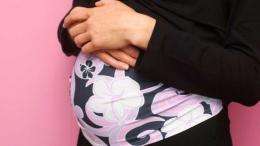Delivering better ways of preventing stillbirth

(Medical Xpress) -- Despite recent dramatic reductions in cot death rates in the UK, and the development of sophisticated screening for Down’s syndrome, preventing stillbirth is proving tougher to tackle. Now, a major study under way at Cambridge could change all that.
In the UK, one in every 200 women reaching their 24th week of pregnancy will have a stillborn baby. That means stillbirth is ten times more common than cot death and three times more common than Down’s syndrome.
Yet compared with cot death, rates of stillbirth have fallen little over the past decade. And whereas women now have access to sophisticated screening for Down’s syndrome, the way we screen for stillbirth still relies on little more than a tape measure. According to Professor Gordon Smith of the Department of Obstetrics and Gynaecology: “When we think of serious complications of pregnancy one of the most common is stillbirth. But if you look at how we screen for stillbirth, for the general low-risk population – which is the population that has most stillbirths because there are more of them – the only currently recommended way of screening is measuring the size of the uterus with a tape measure.”
For parents, a stillborn baby is tragedy. Many of these tragedies could be prevented given better ways of predicting which women are at most risk. Which is why in 2008 Professor Smith set up the Pregnancy Outcome Prediction Study (POPS).
One the largest and most robust studies of its kind, the four-year, National Institute for Health Research (NIHR)-funded study involves more than 4,000 volunteers – women in their first pregnancies who agree to take part in the research when they book their first scan at the Rosie Maternity Hospital in Cambridge. Having currently recruited 4,200 women, the project is on target to reach a total cohort of 4,500 by July 2012.
As well as their routine ultrasound scans at 12 and 20 weeks, the women have blood tests, and additional research scans at 28 and 36 weeks, and when they give birth a sample of the placenta is kept and stored. Combining all this information will, Professor Smith believes, provide a clearer picture of how best to identify women at increased risk of stillbirth.
“The aim of POPS is to try and identify whether there’s a combination of ultrasound and biochemical markers that better predict high-risk pregnancy, and which when applied in a screening programme would reduce the number of stillbirths,” he said.
“The basic premise is that by studying the placenta and comparing it with controls, we can identify the things which are different in the placenta of a complicated pregnancy. And the rationale for studying the placenta is that there’s a great deal of evidence to indicate that many stillbirths are related to an abnormal placenta.”
Knowing which women are at higher risk of stillbirth would allow clinicians to decide how best to intervene to reduce that risk. “Initially, we would see this information being used to predict complications at term, 37 weeks and beyond, which is when one third of stillbirths occur,” Professor Smith explained.
“One of the key things for me is the prospect of intervention, and the most obvious intervention is to deliver the baby early. Stillbirth often results from a diseased placenta so it’s hard to treat, but once a woman reaches the 37th or 38th week of pregnancy you have the option of inducing labour,” he said.
“Or it might be that we simply monitor the baby continuously during labour, or advise against certain women giving birth at home or in a midwife-led unit.”
Cambridge is ideally placed to conduct a study like POPS. As well as having hundreds of willing volunteers, “Cambridge is probably the strongest centre in the world for people with an interest in the biology of the placenta,” explained Professor Smith. “We also have the Centre for Trophoblast Research, which brings together clinical and non-clinical researchers working on the placenta, and we have close links with the School of Biological Sciences, the Gurdon Institute and the Babraham Institute.”
The funding from NIHR to create the resource has enabled Smith to leverage additional support; the project currently receives funding from the Wellcome Trust, the Medical Research Council, British Heart Foundation, and the Stillbirth and Neonatal Death Society.
Coupled with great researchers, Cambridge excels in clinical research design, without which developing screening to reduce stillbirth would be impossible, he said: “Good scientists need well-defined material to study, and what we have in POPS is real excellence in clinical research design coupled with excellent basic science.”
If the results from POPS do identify ultrasound and biochemical markers that predict risk of stillbirth, the next stage would be a trial to test the effectiveness of the screening and intervention. “The ultimate aim would be for our work to become part of a NICE guideline, changing the antenatal care women receive,” he said. “It’s early days but our initial analysis looks very promising.”

















